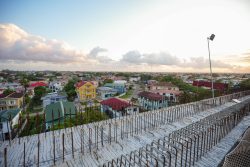A recent press release from the Attorney General’s Chambers slid past the public without comment, partly because it referred to a matter which had its origins five years ago and partly because given the drama of the last few months and the accession of a new government to office, it got submerged under a welter of more compelling news stories. It related to a ruling by Chief Justice Roxane George that found in favour of the Cheddi Jagan Research Centre Inc. in its occupation of Red House.
In August 2015 during the Budget debate, then Minister of the Presidency Joseph Harmon drew to public attention the fact that the Red House on High Street had been leased by the previous PPP/C administration to a private company (i.e. the research centre) for 99 years at a rate of $1,000 a month. It was state property, and had been renovated by the government at a cost of millions. The building, which acquired its name on account of its colour, and not, as one particularly acrimonious PPP press release claimed, because of its association with the ‘red’ beliefs of Cheddi Jagan, is a 19th century structure.
For more than a quarter of a century it was the home of the various colonial secretaries, and then in 1961 it became the residence of Cheddi Jagan after he assumed the premiership. He vacated it in 1964 after he lost the election of that year, and thereafter it was used by various public agencies until 1972 when it became the Kamana Court. Under the earlier PNC government it had been subject to a measure of neglect, and as a building of some importance to the city’s heritage no one could have quarrelled with the PPP/C administration’s decision to rehabilitate it.
It might be noted that that government’s restoration efforts were highly selective, and they were quite content to watch City Hall deteriorate badly without attempting any intervention, and worst of all, to allow the New Amsterdam Hospital to fall into complete ruin. It is a record posterity will not forget. What set Red House apart from the other heritage buildings, however, was the fact that it had an association with the party’s icon, Dr Cheddi Jagan. Freedom House therefore identified it as the site to store records pertaining to his period in office in addition to other memorabilia associated with him, and duly set up a private company to manage the collection and the building.
An old wooden building is never the recommended place to store records, but the PPP was more wedded to sentiment than practicalities. But that is not the main issue. To let a state property in a prime location at a peppercorn rent to a private company for 99 years, and then have the state pay the staff afterwards carries a prima facie aura of misconduct at best and corruption at worst.
On December 29, 2016 then President David Granger ordered that the lease for the Cheddi Jagan Research Centre Inc. be revoked, and that the occupants vacate the property by December 31. Subsequently workers from the Ministry of the Presidency were dispatched to gain forcible entry, in the process of which they tore down the sign outside the building and changed the padlock. It was a clumsy and unnecessary move, and the centre rushed to court to obtain a conservatory order to freeze the instruction that they vacate the premises. It was this order which was heard and determined recently by the Chief Justice.
The then head of state also directed that the building be assigned to house “The National Trust of Guyana, its staff, stores and equipment,” with effect from January 1, 2017. Given the court injunction, that was not to be.
Before it got to this stage, however, the administration of the time had attempted negotiations, proposing that the Red House become the repository for information on and papers generated by all of Guyana’s presidents. The PPP was having none of it. If nothing else the Red House stands as a symbol of the great divide in Guyana’s politics. In one of its more intemperate communications, the party said that, “In the circumstances, it would be anathema to disperse, integrate and to contaminate all that Jagan stood and fought for with the reactionary pro-imperialist, repressive and oppressive praxis of the Burnham/Hoyte regime.”
Most significantly, and in contrast to the posture it is seemingly cultivating currently, it said: “Moreover, looked at in the context of the wider society, since there is certainly no semblance of unity nor cooperation between the PPP and the PNC, why seek to promote a falsehood by placing the founder leaders and political adversaries of these parties under one roof?” And in case anyone believes that Freedom House is unreservedly committed to intellectual freedom, there it was four years ago telling the nation: “It is interesting to note that some countries have criminalized the negationist revisionism of certain historical events as well as the denial and minimization of historical events associated with outstanding personalities in their countries’ history. Guyana need not go in that direction save there is total national unanimity and consensus to go that far.” This is a discomfiting acknowledgement that the PPP is not opposed to “that direction” in principle.
At the very least, this is all about hagiography, not history which must involve open debate not received interpretations. It is undemocratic societies which try to control ‘history’ by only allowing the public access to approved versions of personalities and past events.
Former President Granger was not wrong about archival collections. Archives in democratic nations all over the world collect papers indiscriminately − from the thugs as much as from the heroes − and they are catalogued according to principles which have nothing to do with how they are judged or what they accomplished or destroyed. There may be good reasons not to deposit presidential papers in the National Archives given its past record, but this is too small a society to have a plethora of presidential libraries such as they have in the United States. A single repository for presidential papers with each collection catalogued separately, is not an unreasonable suggestion.
As it was AG Basil Williams maintained that the research centre’s occupation of Red House was illegal, on the grounds (among various other things) that there was no evidence former President Donald Ramotar had granted it a lease, and that the Red House was a National Monument vested in the National Trust. Where the first of these is concerned he could certainly be forgiven, because the former head of state admitted subsequently he had not signed anything, although he said he had approved the lease. As for the second, one is tempted to the view that the AG’s Chambers were perhaps a little careless in their research.
The situation has now been clarified with the Chief Justice finding, among other things, that Red House had not been properly registered in accordance with the National Trust Act and could not therefore be categorized as a National Monument; and that the word of former President Ramotar that he had granted the lease was accepted. Furthermore, the court found that the lease had not been properly revoked by President Granger and could only have been revoked for cause, but there was no evidence as to the breach of the lease by the lessee.
So the Cheddi Jagan Research Centre Inc. has the Red House back, although ideally it should not have been housed in state property in the first place, let alone a heritage building whether or not registered with the National Trust, and certainly not on payment of such a risible rent. It should have sought private premises for the collection − preferably concrete – where it would have been responsible for all its own expenses. The least it can commit to now is the payment of its own staff, which should not become a burden on the taxpayer.
Finally, one can only express the hope that the PPP can overcome its Leninist obsessions, and have an open door policy to research, so historians of all persuasions can be given access to its resources, many of which are of historical importance. No party in a democracy should be talking about the APNU+AFC or anyone else “subvert[ing] the annals of history and allow[ing] historical revisionism to prosper in our society to the detriment of present and future generations.”





